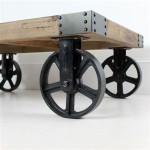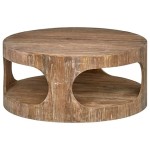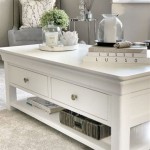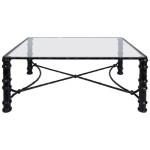How To Paint a Coffee Table Rustic Wood
Achieving a rustic wood finish on a coffee table through paint is a popular and cost-effective way to add character and charm to living spaces. This method allows for the transformation of inexpensive or outdated furniture into pieces that resemble aged, weathered wood, typically requiring more extensive and costly processes to obtain naturally.
The process involves several key steps, from preparing the surface to applying and manipulating the paint to create the desired visual effect. Attention to detail in each stage is crucial for a successful outcome that mimics the authentic look of rustic wood. Selection of appropriate materials and techniques is paramount to achieving the desired aesthetic.
Key Point 1: Surface Preparation and Priming
Proper preparation of the coffee table's surface is arguably the most critical step in achieving a lasting and aesthetically pleasing rustic finish. This stage ensures that the paint adheres correctly and that the final result is durable and resistant to wear.
The initial step involves cleaning the coffee table thoroughly. Any dirt, grease, wax, or existing finish must be removed. A mild detergent and water solution is generally effective for cleaning. For heavily soiled surfaces, a stronger degreaser may be necessary. After cleaning, the surface should be rinsed with clean water and allowed to dry completely.
Following cleaning, the existing finish needs to be addressed. If the existing finish is in good condition and smooth, scuff sanding is sufficient. This involves using fine-grit sandpaper (typically 220-grit) to lightly roughen the surface, creating a better grip for the primer. If the existing finish is peeling, chipping, or otherwise damaged, it should be completely removed. Sanding is the most common method for removal. A power sander can expedite this process, but care should be taken not to damage the underlying wood. Alternatively, a chemical stripper can be used, following the manufacturer's instructions carefully.
Once the surface is clean and the existing finish is properly prepared, it's time to apply a primer. Primer serves several crucial purposes. It seals the wood, preventing uneven absorption of the paint. It provides a uniform surface for the paint to adhere to, and it can block stains from bleeding through the paint. An oil-based primer is generally recommended for wood, as it provides excellent adhesion and stain-blocking properties. However, water-based primers are also suitable, especially for projects where minimizing volatile organic compounds (VOCs) is a priority. Select a primer that is compatible with the type of paint to be used for the topcoat. Apply the primer in thin, even coats, using a brush, roller, or spray gun, depending on the primer's formulation and the desired finish. Allow the primer to dry completely according to the manufacturer's instructions, typically 24-48 hours. Lightly sand the primed surface with fine-grit sandpaper to create an exceptionally smooth base prior to painting.
The choice of primer color can also influence the final look of the rustic finish. Using a tinted primer that complements the topcoat color can enhance the depth and dimension of the paint job. For example, a gray-tinted primer can add a subtle aged look to a white or light-colored topcoat.
Key Point 2: Applying the Base Coat and Subsequent Layers
With the surface properly prepared and primed, the next step is to apply the base coat. This layer sets the foundation for the rustic effect and influences the overall color and tone of the finished coffee table.
The choice of paint for the base coat is crucial. Latex or acrylic paint is commonly used for furniture projects. Latex paint is water-based, easy to clean up, and dries relatively quickly. Acrylic paint is known for its durability and resistance to fading. A matte or flat finish is generally preferred for the base coat, as it provides a better surface for subsequent layers to adhere to and contributes to the rustic aesthetic. The color of the base coat should be chosen to complement the desired rustic look. Earth tones, such as browns, grays, and off-whites, are popular choices. The base coat should be applied in thin, even coats, using a brush, roller, or spray gun. Multiple thin coats are preferable to a single thick coat, as they reduce the risk of drips, runs, and uneven coverage. Allow each coat to dry completely before applying the next.
Once the base coat is dry, the next step is to apply subsequent layers to create the rustic effect. Several techniques can be used to achieve the desired look.
Dry Brushing: This technique involves using a dry brush with a small amount of paint to create a textured, streaky effect. Dip the brush lightly into the paint and wipe off most of the excess onto a paper towel. Then, lightly drag the brush across the surface of the coffee table, following the grain of the wood. This will leave behind streaks of paint that mimic the look of aged wood. Different colors can be used for dry brushing to add depth and dimension.
Color Washing: Color washing involves applying a diluted layer of paint over the base coat. Mix the paint with water or a glazing medium to thin it out. Apply the diluted paint to the surface and then immediately wipe it off with a clean cloth, leaving some of the paint in the crevices and details. This technique creates a subtle, washed-out effect that adds to the rustic look.
Layering: Layering involves applying multiple coats of different colors of paint, allowing some of the underlying layers to show through. This can be achieved by sanding through the top layers of paint or by using techniques such as dry brushing and color washing. Experiment with different color combinations to create a unique and aged look.
The specific techniques and color combinations used will depend on the desired rustic aesthetic. It's recommended to experiment with different techniques on a scrap piece of wood before applying them to the coffee table. This allows you to fine-tune your approach and ensure that you're happy with the results.
Key Point 3: Distressing and Sealing
The distressing process is crucial for achieving an authentic rustic look on the painted coffee table. It involves deliberately creating imperfections and signs of wear to mimic the natural aging process of wood.
Several techniques can be used for distressing. Sanding is a common and effective method. Use sandpaper (varying grits, such as 80-grit to 220-grit) to remove paint from specific areas, such as edges, corners, and raised details. This reveals the underlying layers of paint and creates a worn appearance. Focus on areas that would naturally experience wear and tear over time.
Another popular technique is using a chipping and crackling medium. These mediums are applied between layers of paint and cause the top layer to crack and chip as it dries, creating a aged and distressed look. Follow the manufacturer's instructions carefully when using these mediums.
Physical distressing can also be incorporated. This involves using tools such as hammers, chains, and screwdrivers to create dents, scratches, and other imperfections on the surface of the coffee table. Be careful not to overdo it, as too much distressing can look artificial. The goal is to create subtle imperfections that enhance the rustic look.
After distressing, it is necessary to seal the painted surface to protect it from wear and tear and to ensure its longevity. A clear topcoat will protect the paint from scratches, stains, and moisture. Polyurethane, varnish, and lacquer are common choices for sealing painted furniture. Polyurethane is a durable and water-resistant option, making it suitable for high-traffic areas. Varnish provides a traditional finish with a warm glow. Lacquer dries quickly and creates a hard, durable surface. Choose a sealant with a matte or satin finish to maintain the rustic aesthetic.
Apply the sealant in thin, even coats, using a brush, roller, or spray gun. Allow each coat to dry completely before applying the next. Lightly sand the surface between coats with fine-grit sandpaper to create a smooth finish. Multiple coats of sealant are recommended for maximum protection. Ensure adequate ventilation during the application and drying process, especially when using oil-based sealants.
Once the final coat of sealant is dry, allow the coffee table to cure completely before placing items on it. Curing allows the sealant to fully harden and provides maximum protection. The curing time will vary depending on the type of sealant used, but it is generally recommended to wait at least 24-48 hours. The combination of careful surface preparation, skillful paint application, deliberate distressing, and protective sealing will result in a coffee table with a beautifully aged, rustic wood appearance that elevates any living space.

Distressed Coffee Table A Revisit Rework The Painted Hive

Diy World Market Coffee Table Makeover Liz Marie Blog

How To Refinish A Rustic Wood Coffee Table With Beautiful Results

20 Coffee Table Makeover From Orange Oak To White

How To Refinish A Rustic Wood Coffee Table With Beautiful Results

The Boho Coffee Table Milk Paint Experiment I Re Stuff

Diy Painting Aging Techniques For Living Room Coffee Tables My Desired Home

Distressed Coffee Table A Revisit Rework The Painted Hive

How To Refinish A Table Farmhouse Style My 100 Year Old Home

Rustic Coffee Table Makeover Life On Kaydeross Creek
Related Posts








